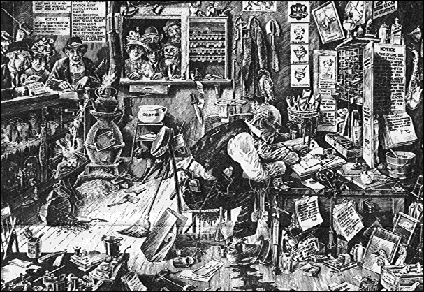Vol. 18 No. 1
January, 1988
|
Make Tomorrow Happen
|

Full Range of Stations
Trailed Railway Builders
|

Dave Jones
|

While the rail gangs were speeding the construction of the Canadian Pacific
Railway main line across the West, another group of men were hard at work on their heels at an equally arduous, and
ultimately no less important, task - station building.
The railway was divided into 125-mile (200-km) sections (later referred to as subdivisions) because this
was the effective distance for steam locomotive operations, at which time they required fuel and water, and normally
a change of crew.
NECESSARY
However, at intervals of seven to 11 kilometres, passing sidings were required for practical operations, and in many
cases this meant the establishment of stations, no matter how rudimentary, to house the company's agents.
At first, these shelters were often nothing more than aging freight car bodies that were unceremoniously dumped
alongside the tracks at chosen sites, awaiting a decision from headquarters as to which of the various
"standard" stations that were devised would be appropriate for the predicted status of each particular
location.
BASIC FORMULA
Although the railway went through several sets of these standards over the years, ranging from the truly utilitarian
to the uniquely picturesque, the formula remained basically the same: small depots for small towns, larger
depots for areas where natural resources or advantages might be exploited, and "Class A" structures for
locations with pretensions to greatness.
The first stations were constructed with amazing dispatch. Specialized gangs would move down the line from building
to building so that several were always under construction at any one time; the first gang putting up the framing,
joisting, and rafters; followed by the sheeting, flooring, and roofing gang; and completed by the plasterers,
joiners, and painters.
In addition to the necessary waiting room ticket office, and freight shed, their layouts included an apartment for
the agent and his family, consisting of a dining room, living room, and kitchen on the ground floor with a couple of
bedrooms on the floor above.
However, they were quite modest structures and lacked almost any sort of comfort, including insulation, storm
windows, or basements, not to mention such luxury items as central heating, running water, electricity, or plumbing
facilities.
NATURE CONSPIRED
Although most of these problems were remedied in the decades that followed, it still took a strong willed family to
live with the rigors of life in the station.
Sure, the effect of trains passing in the night was something that one soon grew accustomed to, but nature could also
conspire against the station-dwellers, sending dust storms so pervasive that even damp cloths placed
against all the cracks around windows and doors could not prevent a thin film of dust from forming on every interior
surface. And the ferocity of Prairie snowstorms is legendary, at times plummeting the temperature to such depths that
frost could be seen on nailheads flush with the interior walls.
For many years water was a scarcity. Often nearby sources were the only resort, but enterprising agents looked to the
skies to fill strategically-located barrels or cisterns with rainwater.
The most important fixture, of course, was a small shed with a half-moon on the door, a short jaunt from
the station itself, some not being displaced by modern plumbing until after the second world war.
Electricity, although introduced in Canada in the 1880s, was not a part of station life at most locations until well
into the 1920s and '30s, and was often installed only after the repeated urgings of the station agent and at his own
expense at that.
But for all their faults, most families who grew up in these local landmarks have only good memories to relate.
After all, most of the drawbacks to life in these depots were symptomatic of life on the Prairies in general and, in
fact, as often as not the station agents family was as comfortably housed as anyone else in the community.
And while the agent himself often performed a dual service to the community as cab driver, insurance broker, travel
agent, club organizer, town councillor, or even mayor, the station was invariably the hub of activity around which
the entire community revolved.
The waiting room was an inviting place to gather around the pot-bellied stove, whether to hold local
meetings of the Boy Scouts, the Masonic Lodge, and the fledgling church organization, or simply to shoot the breeze
on a quiet afternoon.
And the edges of the wooden station platforms were soon rounded off by the women pushing their strollers, the
children playing at their games, and even the marching feet of the local militia units, all in an attempt to escape
the ubiquitous mud that was so much a part of early Prairie life.
This CP Rail News article is
copyright 1988 by Canadian Pacific Railway and is reprinted here with their
permission. All photographs, logos, and trademarks are the property of the Canadian
Pacific Railway Company.
Back |
|